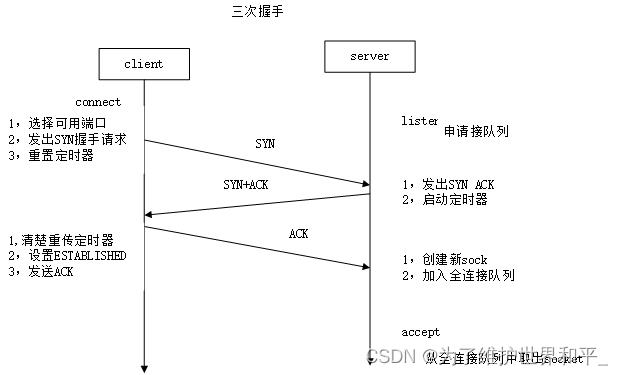TCP建立连接过程(深入源码理解3次握手)
Posted 为了维护世界和平_
tags:
篇首语:本文由小常识网(cha138.com)小编为大家整理,主要介绍了TCP建立连接过程(深入源码理解3次握手)相关的知识,希望对你有一定的参考价值。
从TCP源码上深入了解三次握手过程
应用程序的基本框架
//server
int main()
int fd = socket(AF_INET,SOCK_STREAM,0);
bind(fd,...);
listen(fd,256);
accept(fd,...);
//client
int main()
fd = connect(AF_INET,SOCK_STREAM,0);
connect(fd,...);
三次握手概括

分析开始
客户端connect
int tcp_v4_connect(struct sock *sk, struct sockaddr *uaddr, int addr_len)
//设置socket状态TCP_SYN_SENT
tcp_set_state(sk, TCP_SYN_SENT);
//动态选择一个端口
err = inet_hash_connect(tcp_death_row, sk);
//根据sk中的信息,构建一个SYNC的报文,并将它发送出去
err = tcp_connect(sk);
int tcp_connect(struct sock *sk)
//申请skb
buff = sk_stream_alloc_skb(sk, 0, sk->sk_allocation, true);
//添加到发送队列sk_write_queue
tcp_connect_queue_skb(sk, buff);
tcp_ecn_send_syn(sk, buff);
tcp_rbtree_insert(&sk->tcp_rtx_queue, buff);
//发送syn tcp_transmit_skb
err = tp->fastopen_req ? tcp_send_syn_data(sk, buff) :
tcp_transmit_skb(sk, buff, 1, sk->sk_allocation);
//重启定时器
/* Timer for repeating the SYN until an answer. */
inet_csk_reset_xmit_timer(sk, ICSK_TIME_RETRANS,
inet_csk(sk)->icsk_rto, TCP_RTO_MAX);
return 0;
connect 作用把本地socket状态设置成TCP_SYN_SENT;
选择一个可用的端口,发出SYN握手请求并重置定时器;
服务端响应SYN
int tcp_v4_do_rcv(struct sock *sk, struct sk_buff *skb)
//服务端收到SYN或者第三步ACK都会走到这里
if (sk->sk_state == TCP_LISTEN)
struct sock *nsk = tcp_v4_cookie_check(sk, skb);//查看半连接队列
else
sock_rps_save_rxhash(sk, skb);
//不同的状态处理
if (tcp_rcv_state_process(sk, skb))
rsk = sk;
goto reset;
//服务端处理syn连接请求
int tcp_conn_request(struct request_sock_ops *rsk_ops,
const struct tcp_request_sock_ops *af_ops,
struct sock *sk, struct sk_buff *skb)
//查看半连接队列是否满了,则直接丢弃
if ((net->ipv4.sysctl_tcp_syncookies == 2 ||
inet_csk_reqsk_queue_is_full(sk)) && !isn)
want_cookie = tcp_syn_flood_action(sk, rsk_ops->slab_name);
if (!want_cookie)
goto drop;
//查看全连接队列,如果满了则直接丢弃
if (sk_acceptq_is_full(sk))
NET_INC_STATS(sock_net(sk), LINUX_MIB_LISTENOVERFLOWS);
goto drop;
//分配request_sock内核对象
req = inet_reqsk_alloc(rsk_ops, sk, !want_cookie);
if (fastopen_sk)
af_ops->send_synack(fastopen_sk, dst, &fl, req,
&foc, TCP_SYNACK_FASTOPEN);
/* Add the child socket directly into the accept queue */
else
tcp_rsk(req)->tfo_listener = false;
if (!want_cookie)//添加到半连接队列,并开启定时器
inet_csk_reqsk_queue_hash_add(sk, req,
tcp_timeout_init((struct sock *)req));
//构造synack包
af_ops->send_synack(sk, dst, &fl, req, &foc,
!want_cookie ? TCP_SYNACK_NORMAL :
TCP_SYNACK_COOKIE);
.send_synack就是tcp_v4_send_synack
static int tcp_v4_send_synack(const struct sock *sk, struct dst_entry *dst,
struct flowi *fl,
struct request_sock *req,
struct tcp_fastopen_cookie *foc,
enum tcp_synack_type synack_type)
if (!dst && (dst = inet_csk_route_req(sk, &fl4, req)) == NULL)
return -1;
//构造syn+ack包
skb = tcp_make_synack(sk, dst, req, foc, synack_type);
if (skb)
__tcp_v4_send_check(skb, ireq->ir_loc_addr, ireq->ir_rmt_addr);
rcu_read_lock();
//将synack包发送出去
err = ip_build_and_send_pkt(skb, sk, ireq->ir_loc_addr,
ireq->ir_rmt_addr,
rcu_dereference(ireq->ireq_opt));
rcu_read_unlock();
err = net_xmit_eval(err);
return err;
服务端响应SYN
- 检查半连接与全连接队列是否满,满握手直接丢弃
- 申请request_sock,并添加到半连接队列中
- 构造syn+ack包,通过ip_build_and_send_pkt发送
- 重启定时器tcp_timeout_init
客户端响应SYN+ACK
客户端收到服务端发来的syn+ack包的时候,进入tcp_rcv_state_process
int tcp_rcv_state_process(struct sock *sk, struct sk_buff *skb)
switch (sk->sk_state)
case TCP_CLOSE:
goto discard;
//第一次握手 服务器收到
case TCP_LISTEN:
goto discard;
//客户端第二次握手处理
case TCP_SYN_SENT:
//synack包
queued = tcp_rcv_synsent_state_process(sk, skb, th);
return 0;
static int tcp_rcv_synsent_state_process(struct sock *sk, struct sk_buff *skb,
const struct tcphdr *th)
//step1:
tcp_ack(sk, skb, FLAG_SLOWPATH);
//step2:tcp 建立完成
tcp_finish_connect(sk, skb);
if (sk->sk_write_pending ||
icsk->icsk_accept_queue.rskq_defer_accept ||
inet_csk_in_pingpong_mode(sk))
return 0;
else
//step3:发送确认
tcp_send_ack(sk);
step1:
/* This routine deals with incoming acks, but not outgoing ones. */
static int tcp_ack(struct sock *sk, const struct sk_buff *skb, int flag)
//删除发送队列
flag |= tcp_clean_rtx_queue(sk, prior_fack, prior_snd_una, &sack_state);
//重置定时器
if (flag & FLAG_SET_XMIT_TIMER)
tcp_set_xmit_timer(sk);
step2
void tcp_finish_connect(struct sock *sk, struct sk_buff *skb)
//修改socket状态
tcp_set_state(sk, TCP_ESTABLISHED);
icsk->icsk_ack.lrcvtime = tcp_jiffies32;
//拥塞控制
tcp_init_transfer(sk, BPF_SOCK_OPS_ACTIVE_ESTABLISHED_CB);
tp->lsndtime = tcp_jiffies32;
//打开保活计时器
if (sock_flag(sk, SOCK_KEEPOPEN))
inet_csk_reset_keepalive_timer(sk, keepalive_time_when(tp));
step3:
void __tcp_send_ack(struct sock *sk, u32 rcv_nxt)
if (sk->sk_state == TCP_CLOSE)
return;
//申请和构造ack包
buff = alloc_skb(MAX_TCP_HEADER,
sk_gfp_mask(sk, GFP_ATOMIC | __GFP_NOWARN));
//发送出去
__tcp_transmit_skb(sk, buff, 0, (__force gfp_t)0, rcv_nxt);
总结
- 客户端响应synack,清除重传定时器
- 设置当前状态为ESTABLISHED
- 开启拥塞控制,保活机制
- 发送ack包
服务器端响应ACK
int tcp_v4_do_rcv(struct sock *sk, struct sk_buff *skb)
//服务端收到SYN或者第三步ACK都会走到这里
if (sk->sk_state == TCP_LISTEN)
struct sock *nsk = tcp_v4_cookie_check(sk, skb);//step1:查看半连接队列,新创建线程
//step2:
if (tcp_rcv_state_process(sk, skb))
step1:创建子socket;添加全连接队列
//tcp_v4_cookie_check->cookie_v4_check->tcp_get_cookie_sock
struct sock *tcp_get_cookie_sock(struct sock *sk, struct sk_buff *skb,
struct request_sock *req,
struct dst_entry *dst, u32 tsoff)
struct inet_connection_sock *icsk = inet_csk(sk);
struct sock *child;
bool own_req;
//创建子sock 回调函数在下面tcp_v4_syn_recv_sock
child = icsk->icsk_af_ops->syn_recv_sock(sk, skb, req, dst,
NULL, &own_req);
if (child)
//添加全连接队列
if (inet_csk_reqsk_queue_add(sk, req, child))
return child;
bh_unlock_sock(child);
sock_put(child);
return NULL;
//添加到全连接队列
struct sock *inet_csk_reqsk_queue_add(struct sock *sk,
struct request_sock *req,
struct sock *child)
struct request_sock_queue *queue = &inet_csk(sk)->icsk_accept_queue;
req->sk = child;
req->dl_next = NULL;
if (queue->rskq_accept_head == NULL)
WRITE_ONCE(queue->rskq_accept_head, req);
const struct inet_connection_sock_af_ops ipv4_specific =
.syn_recv_sock = tcp_v4_syn_recv_sock,
//子socket的创建过程
struct sock *tcp_v4_syn_recv_sock(const struct sock *sk, struct sk_buff *skb,
struct request_sock *req,
struct dst_entry *dst,
struct request_sock *req_unhash,
bool *own_req)
struct ip_options_rcu *inet_opt;
//判断队列是否满了
if (sk_acceptq_is_full(sk))
goto exit_overflow;
//创建socket
newsk = tcp_create_openreq_child(sk, req, skb);
if (!newsk)
goto exit_nonewsk;
step2:设置连接状态TCP_ESTABLISHED
int tcp_rcv_state_process(struct sock *sk, struct sk_buff *skb)
switch (sk->sk_state)
case TCP_CLOSE:
goto discard;
//第一次握手
case TCP_LISTEN:
//客户端第二次握手处理
case TCP_SYN_SENT:
switch (sk->sk_state)
//服务器第三次握手
case TCP_SYN_RECV:
//改变连接状态
tcp_set_state(sk, TCP_ESTABLISHED);
总结
- 服务端将状态设置为ESTABLISHED;
- 创建新sock加入全连接队列中
最后accept过程
struct sock *inet_csk_accept(struct sock *sk, int flags, int *err, bool kern)
struct inet_connection_sock *icsk = inet_csk(sk);
//全连接队列获取元素
struct request_sock_queue *queue = &icsk->icsk_accept_queue;
//取出一个给用户使用
req = reqsk_queue_remove(queue, sk);
newsk = req->sk;
从全连接队列中取出一个给用户使用
参考
https://course.0voice.com/v1/course/intro?courseId=2&agentId=0
以上是关于TCP建立连接过程(深入源码理解3次握手)的主要内容,如果未能解决你的问题,请参考以下文章